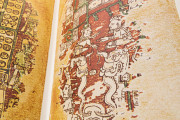The Codex Paris, also known as the Codex Peresianus, is a Maya manuscript created in the mid-fifteenth century. A nearly complete screenfold manuscript book made of amate paper, it originates from the Mayapán region of Yucatán, Mexico. It is probably a copy of a book dating from the Classic period (ca. 250-900) of Mesoamerican civilization. It may have still been in use when the Spanish arrived in the Yucatán in the early sixteenth century. It contains ritual calendars, almanacs, astronomical data, and tools for prognostication. Its pictorial and hieroglyphic content served as a sacred guide to divination and appeasement of sky and earth gods.
The manuscript is composed of eleven panels, each about twice as tall as wide. Most are painted on both sides, and the whole extends to 138 cm when unfolded. Its pictorial program covers twenty of its twenty-two surviving pages (two panels—four pages—are lost). It is especially well known for its richly illustrated constellation pages.
Time Reconning and Prognostication
Like the other surviving Maya screenfolds, which include the Codex Dresden and the Codex Madrid, the Codex Paris is a sacred book of divination. The obverse of the screenfold presents a series of katuns (periods of 7200 days), the Maya unit of measure for recording history. Each page includes a depiction of the Lord of the katun accompanied by glyphs representing periods of time and auguries. The reverse includes information about the prognostication of rainfall and maize crop yields, as well as information about spirit forces. The manuscript concludes with two pages showing thirteen constellations of the Maya sky. All of the images and glyphs are executed in black outline, and the color palette is dominated by red.
Style Reflecting Yucatán Visual Tradition
Images typical of the east coast style of Tancah, Tulum, Cobá, and Mayapán appear in the Codex Paris. Textual content and aspects of the formal arrangement recall those of a Mayapán stela containing katuns. Aesthetic similarities have also been seen in the rendering of wall paintings at Tancah, Cobá, and Tulum.
From Yucatán to Europe
The exact route the Codex Paris traveled from Mexico to Europe is unknown. The manuscript made its way to the Bibliothèque Imperiale, now the Bibliothèque nationale de France, in 1832. It has been proposed that the codex may have been in a private collection before arriving in Paris. It earned the nickname Codex Peresianus (Codex Pérez) in the mid-nineteenth century from a now lost paper wrapper with the name "Pérez" written on it.
We have 1 facsimile edition of the manuscript "Codex Paris": Codex Peresianus facsimile edition, published by Akademische Druck- u. Verlagsanstalt (ADEVA), 1968
Request Info / Price











